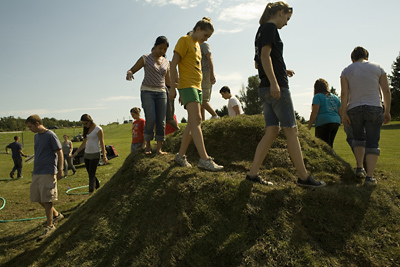Soil, grass and mud: Art of Horticulture students create sculpture from the earth
By Joe Wilensky

"Cool, dirty, awesome."
That's how Zack Aburahma, a senior nutritional sciences major, described the 10-ton earth-and-sod sculpture that he and two dozen other students in the Art of Horticulture class created Sept. 4 at Cornell's turfgrass plots off Warren Road.
In the past, students taking this course completed final projects involving turfgrass, but this was the first time the entire class worked on a large-scale project together, early in the semester.
"I was a little nervous about our ability to complete it, but it's amazing -- they literally jumped in with their feet, and started this spiral path to the top and got completely covered in mud," said Marcia Eames-Sheavly, a senior extension associate who teaches the course. "It does give them a sense of how accessible earth art can be. I love this."
It was a nearly perfect early September afternoon, and the earth was indeed very accessible; students -- some in boots or sneakers and many barefoot -- shaped the sculpture and regularly hosed the earth and sod down to keep it in place, getting quite muddy and wet in the process.
The students, many from the College of Agriculture and Life Sciences (CALS) but some also from the Hotel School, the College of Human Ecology and the College of Engineering, say they were attracted to the class because of its emphasis on art -- and its hands-on aspects.
"It's a great class because anyone can take it, from any different major," said Jessica Schisano, a senior communications major. "It's the first time I ever got the opportunity to take a class that allowed me to get dirty.
"My grandmother has a farm in New Paltz, N.Y., so I've always been involved in the garden and planting things, and I've always loved it," she said. "So this gave me a chance to do a little bit of that at Cornell without being a full-fledged horticulture or plant science major."
The students began planning for the project the previous week following a presentation to the class by Frank Rossi, associate professor of horticulture and a turfgrass specialist who has worked on high-profile projects at Yankee Stadium and Lincoln Center. They came up with a plan for a pile of approximately 70 cubic yards of soil sitting out near Cornell's turf plots -- a sculpture that could be completed in three hours, including stripping off long lines of nearby sod to cover the artwork.
The resulting mound with a spiral path to the top, molded and stamped into place by many pairs of hands and feet, reinforced the combined efforts of the students -- and allowed them to march to the top and celebrate the sculpture's completion.
"Living sculpture is art made with growing plants and can range from tree sculpture, to crop art, mowing patterns, topiary, turf works and more," Eames-Sheavly said. The living sculpture project is an important focus in the Art of Horticulture course; art created from earth also is a focus in the department's extension and outreach projects.
Inspiration for the large-scale project came in part from a popular final project made for the class in 2006 by Danielle Hodgins '08. Her larger-than-life sod cow, named Misty Sue, spent weeks sitting peacefully in front of Morrison Hall.
Matt Zimmerman, a CALS business major, says he is taking the class "to have something fun to do senior year, to do something completely different." But he appreciates the planning and work the project required: "We're certainly not getting dirty in any of our finance classes," he remarked. "And this is a lot more fun."
Media Contact
Get Cornell news delivered right to your inbox.
Subscribe